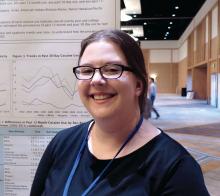SAN DIEGO – Use of cocaine by young adults in the United States has declined significantly since the early 2000s, but it remains relatively common. In fact, results from an analysis of national data suggest that about 5% of 18- to 22-year-olds have used cocaine in the past 12 months.
“We don’t typically think of cocaine use amongst young people, but it is of a nontrivial prevalence,” lead study author Kristin E. Schneider said in an interview at the annual meeting of the College on Problems of Drug Dependence. “If someone has risky alcohol use they might also have risky substance use. We need to be screening for those things as well, while most interventions these days focus on problem drinking.”
Ms. Schneider, a graduate student in the department of mental health at Johns Hopkins University, Baltimore, and her associates drew from the 2002-2014 waves of the National Survey on Drug Use and Health to describe trends in cocaine use among young adults by race/ethnicity, sex, and college enrollment. They assessed for lifetime use, any past 12-month cocaine use, past 30-day use, and any past 12-month use disorder. They also tested for linear and quadratic trends over time.
When the researchers averaged across all years, they found that 12.1% of young adults had ever used cocaine, 5.9% had used it in the past 12 months, 1.8% had used in the past 30 days, and 1% had a use disorder in the past 12 months. They also observed significant linear declines in cocaine use across the entire study period. For example, between 2002 and 2014, the prevalence of lifetime cocaine use declined from 13.7% to 8.6%, past 12-month use declined from 6.3% to 4.1%, and past 30-day use declined from 1.8% to 1.4%.
Nonstudents had higher lifetime rates of cocaine use, compared with students (14.8% vs. 7.8%, respectively), but differences between the two groups were small for other indicators. “Perhaps being an emerging environment with other [young] adults who are also making risky health behavior decisions compensates for this baseline difference of risk between people who go to college and those who do not,” Ms. Schneider said. At the same time, the lowest rates of past 12-month cocaine use was observed in black males (1.6%), Asian females (0.8%), and black females (0.8%).
The National Institute on Drug Abuse supported the study. Ms. Schneider reported having no financial disclosures.


